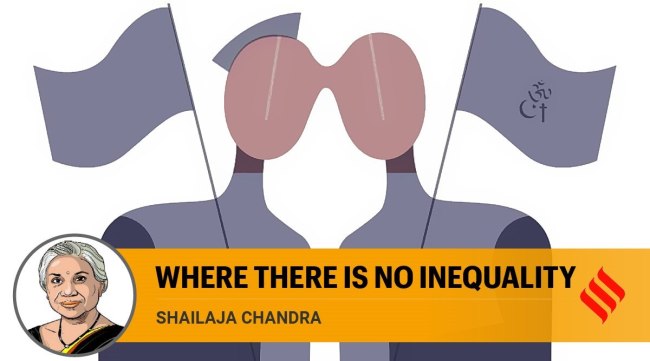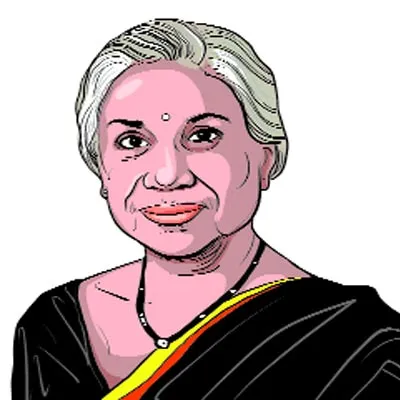Opinion Shailaja Chandra writes: Where there is no inequality
I dream of an India more open-minded and egalitarian, where the walls of caste and class have broken down, writes Shailaja Chandra.
 My first vision is to secure freedom from casteism — something that has not happened in 75 years.
My first vision is to secure freedom from casteism — something that has not happened in 75 years. When India celebrates one hundred years since Independence, I may not be around. But no one can stop me from dreaming about an India that, by then, should become more egalitarian and more open-minded. It is that vision that permeates my thoughts today. While there will always be a need for improved health and education, better infrastructure and connectivity, growth in global competitiveness, and improvement in the quality of life, these are, in their very nature incremental. The way we are going, all these things will improve sooner than later. I would like instead to use this opportunity to dream and strike where it hurts. To me, four things stand out as most important.
First, to have a country free of caste — where being a Brahmin, a Kshatriya, a Bania, an OBC, a Dalit or a tribal does not matter. Second, to see those responsible for governing and protecting citizens made much more accountable — not so much by the law and the courts, as much as by citizens. By voters being able to distinguish between good governance and pretence. Third, to bridge the class divide in a country where paymasters and workers, no matter how skilled or how loyal, are underpaid, kept at arm’s length, and notoriously underpaid. I share my thoughts on making it happen.
My first vision is to secure freedom from casteism — something that has not happened in 75 years. The Scheduled Castes and Tribes listed in the Constitution have over 1,000 castes identified as once having faced deprivation, oppression, and social isolation. Over 740 tribes, who have distinct cultures and live in geographical isolation, are similarly protected. These groups constitute around 22 per cent of the population and have been receiving the benefit of laws, reservation, and a slew of social and economic benefits to overcome past and ongoing discrimination. Notwithstanding their finding political voice and reservation in government services, these efforts have been effective only in small proportions — those who were better placed initially, through access to education or their own initiative, continue to benefit. Affirmative action has not addressed the root causes of the continuing predicament of these groups.
So, while not even suggesting changing the Constitution, has the time come to identify deprivation differently? I would like to see an India where we identify deprivation not just by the caste name being included in the state lists by nativity, but by identifying families among these very groups where not even one woman in the family has studied beyond Class 8 or is a wage earner in the labour force. These signs of deprivation have many longer-term effects on the wellbeing of the family and on children’s health and education. We need to have a census of such women among the Scheduled Castes and Tribes and work towards educating and equipping them with one test of success — have they passed a minimum of a Class 10 examination and joined the labour market? Lower caste women bear discrimination of caste and gender. Empirical evidence suggests that money in the hands of mothers (as opposed to their husbands) benefits children. With fertility declining, the goalposts should be changed because India is the only country where women’s labour force participation seems to be declining.
Second, among the middle classes, I would like to see a breakdown of the walls that separate community and caste. Let more inter-caste marriages bloom and let the diversity of cultures create a band of young Indians who do not need to go to caste-based sites to select a partner. Young people’s education should equip them to understand and welcome multi-culturist attitudes to eating, dressing, speech and social mixing. Only then will the social cohesion that India receives high marks for internationally, percolate into the aspirant middle classes by choice.
Third, I would like to see young Indians participating in a thinking way in the way elections are fought and votes cast. The middle class is not small. A third of India can by most accounts be considered middle class. These people are educated, mobile and have opinions. But they do not care to vote. They do not know who their local councillor or MLA or MP is. Where then is the question of holding these “public representatives “accountable? If every adult middle-class man or woman decided to find out more about their political candidates, demanded to know what candidates and elected representatives have been doing or will do for them and force them to debate on issues that matter, it would shame those who simply ride the wave of a party. I would like the media to be assertive, not choosing their targets. In the UK, ministers are forced to resign over unethical conduct or immoral behaviour. By the time, the Indian Republic is 100, our citizens must gather voice to question, debate, discuss and kick out those who only sit as cheerleaders for their political party.
Finally, I would like to see a classless society which exists in India but which we have never taken note of. On a posting to Manipur in 1971, I was unaccustomed to seeing the baby minder (ayah) sleeping on my bed, the baby alongside. Likewise, my office peon came straight into our drawing room and occupied the sofa. The Manipuris, whether they are Meities from the Imphal Valley or tribals from the hills, live in a classless society. In Mizoram, those cooking and serving the food for a party, eat at the same table — not in some corner at the back of the house! We see our children living outside India coughing up hundreds of dollars for a plumber’s visit and offering tea while we do not even offer cold water!
My thoughts are big and small. Twenty-five years is a long time to make this happen!
The writer is a former secretary in the Ministry of Health. This article is part of an ongoing series, which began on August 15, by women who have made a mark, across sectors




